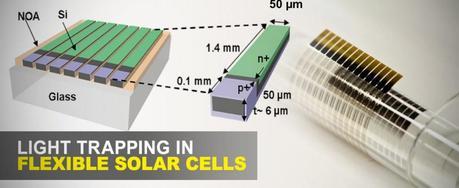 (Credit: University of Central Florida, Nano-Optics Research Group)
(Credit: University of Central Florida, Nano-Optics Research Group)
A team of researchers from the University of Illinois at Urbana-Champaign and the University of Central Florida in Orlando implemented light trapping schemes with 3 μm thick silicon solar cells, achieving energy conversion efficiencies that are higher by ≈190% compared to otherwise identical cells that do not exploit light-trapping features.
Researchers have created large sheets of nanotextured, silicon micro-cell arrays that hold the promise of making solar cells lightweight, more efficient, bendable and easy to mass produce.
Light trapping is a technique used to make the optical path length longer than the length (thickness) of the actual solar cell. The optical path is the path that light takes in traversing the solar cell. To give an example, for a solar cell with no light trapping scheme the length of an optical path may be equal to the length of the device itself. In a solar cell with light trapping schemes in place the optical path length can be 40 or more times greater than the length of the device.The team used a light trapping scheme based on a nanoimprinting technique where a polymeric stamp mechanically emboss the nano-scale pattern on to the solar cell without involving further complex lithographic steps. This approach has led to the flexibility researchers have been searching for, making the design ideal for mass manufacturing, said UCF assistant professor Debashis Chanda, lead researcher of the study.
Previously, scientists had suggested designs that showed greater absorption rates of sunlight, but how efficiently that sunlight was converted into electrical energy was unclear, Debashis said. This study demonstrates that the light trapping scheme offers higher electrical efficiency in a lightweight, flexible module.
The team believes this technology could someday lead to solar-powered homes fueled by cells that are reliable and provide stored energy for hours without interruption.
Ki Jun Yu, Li Gao, Jae Suk Park, Yu Ri Lee, Christopher J. Corcoran, Ralph G. Nuzzo, Debashis Chanda, John A. Rogers (2013). Light Trapping in Ultrathin Monocrystalline Silicon Solar Cells Advanced Energy Materials, 3 (11), 1401-1416 DOI: 10.1002/aenm.201370046
